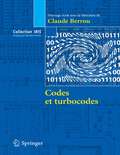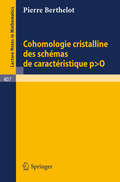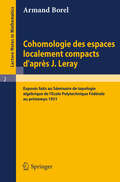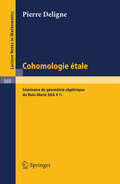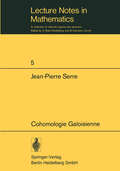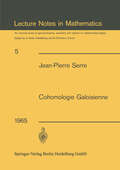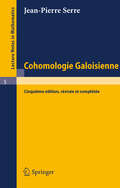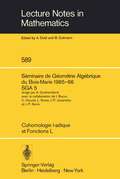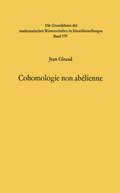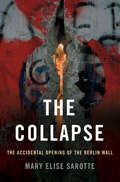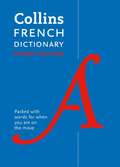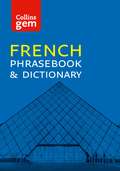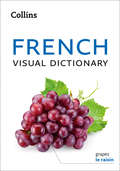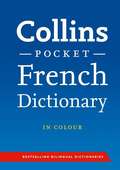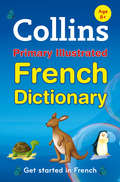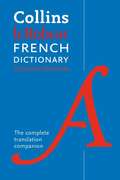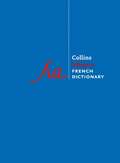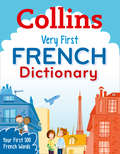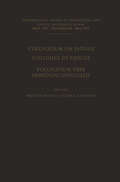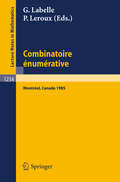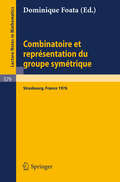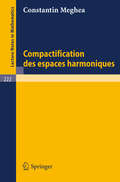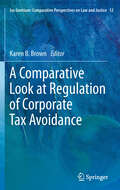- Table View
- List View
Codes et turbocodes (Collection IRIS)
by Claude Berrou Nicolas PuechCet ouvrage est consacré à l'une des fonctions essentielles des systèmes de télécommunications modernes : le codage de canal ou codage correcteur d'erreurs. À la croisée de la théorie de l'information, des mathématiques et de l'électronique, le codage de canal a connu de nombreux développements depuis les travaux fondateurs de Claude Shannon. Du simple code de Hamming (1950) aux récents turbocodes (1993) en passant par les codes LDPC (1962), le codage de canal a considérablement évolué et a intégré des concepts de plus en plus sophistiqués, en particulier le traitement probabiliste de l'information. Codes algébriques, codes convolutifs et codes concaténés décodés itérativement font la matière principale de l'ouvrage qui comporte également une présentation des modulations numériques, auxquelles le codage de canal est intimement associé pour former le cœur de la couche physique des systèmes de télécommunications. Les aspects théoriques les plus importants sont présentés, la construction des codes est détaillée et justifiée. Les algorithmes de décodage sont développés et, dans la mesure du possible, accompagnés de résultats de simulation, caractéristiques de leur pouvoir de correction et de leurs applications. Les auteurs sont des enseignants-chercheurs reconnus pour leur expertise dans le domaine des algorithmes de codage et de décodage ainsi que des circuits électroniques associés. Codes et Turbocodes a été pensé pour être à la fois un ouvrage de découverte du domaine, une source précieuse d'informations sur les nombreuses techniques imaginées depuis le milieu du vingtième siècle, et une ouverture vers des problèmes non encore complètement résolus.
Cohomologie Cristalline des Schemas de Caracteristique p O (Lecture Notes in Mathematics #407)
by P. BerthelotCohomologie des espaces localement compacts d'apres J. Leray: Exposes faits au Seminaire de topologie algebrique de l'Ecole polytechnique federale au printemps 1951 (Lecture Notes in Mathematics #2)
by Armand BorelCohomologie Etale: Séminaire de Géométrie Algébrique du Bois-Marie SGA 4 1/2 (Lecture Notes in Mathematics #569)
by Pierre Deligneltats – avec une généralité minimale, souvent insuffisante pour les applications –et une idée de leur démonstration. Pour des résultats complets, ou des démonstrationsdétaillées, SGA 4 reste indispensable.Le “Rapport sur la formule des traces” contient une démonstration complété dela formule des traces pour l’endomorphisme de Frobenius. La démonstration est celledonnée par Grothendieck dans SGA 5, élaguée de tout détail inutile. Ce rapportdevrait permettre à utilisateur d’oublier SGA 5, qu’on pourra considérer comme unesérie de digression, certaines très intéressantes. Son existence permettra de publierprochainement SGA 5 tel quel. Il est complété par l’exposé “Applications de laformule des traces aux sommes trigonométriques” qui explique comment la formuledes traces permet l’étude de sommes trigonométriques, et donne des exemples..
Cohomologie Galoisienne: Cours au Collège de France, 1962–1963 (Lecture Notes in Mathematics #5)
by Jean-Pierre SerreCohomologie Galoisienne: Cours au College de France, 1962-1963 (Lecture Notes in Mathematics #5)
by Jean-Pierre SerreCohomologie Galoisienne (Lecture Notes in Mathematics #5)
by Jean-Pierre SerreThis new edition includes a survey (mostly without proofs) of the main results obtained in the 30 years following original publication. It also incorporates newer material, including two "résumés de cours" at the Collège de France (1990 - 1991 and 1991 - 1992), and an updated bibliography.
Cohomologie l-adique et Fonctions L: Séminaire de Géométrie Algébrique du Bois-Marie 1965-66, SGA 5 (Lecture Notes in Mathematics #589)
by Ionel Bucur Alexander Grothendieck Christian Houzel Luc Illusie Jean-Pierre Jouanolou Jean-Pierre SerreCohomologie non abelienne (Grundlehren der mathematischen Wissenschaften #179)
by Jean GiraudNow a common tool and object of study, stacks were introduced in this book as a framework for the study of non-abelian cohomology classes in degrees 1 and 2 on an arbitrary topos. The book shows that these cohomology classes can be represented by geometric objects called torsors and gerbes, and provides a detailed study of their basic properties. Since their introduction in this book, gerbes have become a widespread tool in geometry and topology. A timeless classic, this French language book remains to this day a key reference for fibred categories, stacks, torsors, gerbes and topos.
The Collapse: The Accidental Opening Of The Berlin Wall
by Mary Elise SarotteOn the night of November 9, 1989, massive crowds surged toward the Berlin Wall, drawn by an announcement that caught the world by surprise: East Germans could now move freely to the West. The Wall,infamous symbol of divided Cold War Europe,seemed to be falling. But the opening of the gates that night was not planned by the East German ruling regime,nor was it the result of a bargain between either Ronald Reagan or George H.W. Bush and Soviet leader Mikhail Gorbachev.It was an accident.In The Collapse , Prize-winning historian Mary Elise Sarotte reveals how a perfect storm of decisions made by daring underground revolutionaries, disgruntled Stasi officers, and dictatorial party bosses sparked an unexpected series of events culminating in the chaotic fall of the Wall. With a novelist's eye for character and detail, she brings to vivid life a story that sweeps across Budapest, Prague, Dresden, and Leipzig and up to the armed checkpoints in Berlin.We meet the revolutionaries Roland Jahn, Aram Radomski, and Siggi Schefke, risking it all to smuggle the truth across the Iron Curtain the hapless Politburo member Günter Schabowski, mistakenly suggesting that the Wall is open to a press conference full of foreign journalists, including NBC's Tom Brokaw and Stasi officer Harald Jäger, holding the fort at the crucial border crossing that night. Soon, Brokaw starts broadcasting live from Berlin's Brandenburg Gate, where the crowds are exulting in the euphoria of newfound freedom,and the dictators are plotting to restore control.Drawing on new archival sources and dozens of interviews, The Collapse offers the definitive account of the night that brought down the Berlin Wall.
Collected Works of Charles François Sturm
by Flavia PadovaniThis volume is based on lectures presented at a colloquium held in Geneva in 2003 to honour the 200th anniversary of the birth of Charles François Sturm in Geneva on September 29, 1803. The focus is on C.F. Sturm's own work and this is the first monograph on his collected papers. These original papers are accompanied by contributions from internationally renowned experts thereby deepening topics like differential equations, optics and algebraic curves.
Collins French Dictionary (PDF)
by Collins Dictionaries StaffA modern French Dictionary offering excellent coverage of today's French language, culture and usage. Clear presentation and colour make it easy to use and its handy format and durability make it your ideal companion at home, school or on your travels. Features include: âe¢ All the latest words in both languages, such as downloadable, Wi-Fi in English, and empreinte écologique, podcaster in French âe¢ Full GCSE coverage âe¢ An in-depth and up-to-date supplement with information about France, its people and its language to help you take your learning to the next level âe¢ Help with French verbs âe¢ Clear, colour layout, useful examples, language and cultural notes Designed to give travellers, business people and the general user alike all the information they need in a portable, hard-wearing format. It includes all the latest words reflecting changes in modern lifestyle, as well as all the features you would expect from a Collins dictionary: an easy-to-read colour layout, special treatment of key words such as can, that, mettre, que, notes about life in French-speaking countries and warnings on commonly confused words. An in-depth and up-to-date supplement helps you to develop your knowledge of French and your confidence in the language, with a section on common translation difficulties to guide you. There is information on pronunciation and improving your fluency, as well as the words and phrases you will need in different situations, like sending an email or making a phone call. The supplement also gives you an insight into France, its people and other French-speaking countries. Verb tables show all verb forms for the most common French verbs and give examples of how these are used.
Collins French Phrasebook and Dictionary Gem Edition: Phrasebook And Dictionary (Collins Gem #04)
by Collins DictionariesYou will never be lost for words in your travels around France again! Your ideal travel companion will ensure that you can say what you need in French with ease and confidence.
Collins French Visual Dictionary (Collins Visual Dictionaries Ser.)
by Collins DictionariesA photographic guide to the key words and phrases in French. This attractive ebook is a perfect travel companion and provides a practical guide to France and French language and culture.
Collins Pocket — COLLINS POCKET FRENCH DICTIONARY [6th edition] (PDF)
by CollinsFeatures include: All the latest words in both languages, such as downloadable, Wi-Fi in English, and empreinte écologique, podcaster in French Full GCSE coverage An in-depth and up-to-date supplement with information about France, its people and its language to help you take your learning to the next level Help with French verbs Clear, colour layout, useful examples, language and cultural notes COLLINS POCKET FRENCH DICTIONARYhas been designed to give travellers, business people and the general user alike all the information they need in a portable, hard-wearing format. It includes all the latest words reflecting changes in modern lifestyle, as well as all the features you would expect from a Collins dictionary: an easy-to-read colour layout, special treatment of key words such as can, that, mettre, que, notes about life in French-speaking countries and warnings on commonly confused words. An in-depth and up-to-date supplement helps you to develop your knowledge of French and your confidence in the language, with a section on common translation difficulties to guide you. There is information on pronunciation and improving your fluency, as well as the words and phrases you will need in different situations, like sending email or making a phone call. The supplement also gives you an insight into France its people and other French-speaking countries. Verb tables show all verb forms for the most common French verbs and give examples of how these are used. Also available in the Collins French dictionary range are Collins French School Dictionary, Collins Easy Learning French Dictionary, Collins French Dictionary & Grammar and Collins French Phrasebooks for mobile phone and iPod
Collins Primary Illustrated French Dictionary
by Collins DictionariesOptimised for colour tablets. The images in this e-book are not suitable for black and white e-ink devices.Collins Primary Illustrated French Dictionary is ideal for young learners of French as their first REAL dictionary. It offers detailed coverage of key French and English vocabulary in a highly attractive, colourful and easy-to-use format.
Collins Robert French Dictionary: The complete translation companion (PDF)
by Collins Dictionaries StaffThis French-English/English-French dictionary, is a collaboration between Collins and Le Robert, now revised and updated with hundreds of new words, phrases and senses. The supplements on communication, education systems and famous people of the French- and English-speaking worlds make this the perfect dictionary for use at college, home or work. Designed for students and professionals using French in the course of their work. Lexicographers draw on Collins' unique multi-million word databases of French and English to ensure that the user has the most complete and accurate picture of real language available today.
Collins Robert French Dictionary (PDF)
by Collins DictionariesThe world's leading French-English dictionary, a joint collaboration between Collins and Le Robert, now revised and updated to cover all the latest vocabulary in both languages. The perfect dictionary for advanced learners of French. With over 310,000 words, meanings and phrases and 500,000 translations. This tenth edition of the market-leading Collins Robert French dictionary uses Collins' and Le Robert's unique multi-million word databases of contemporary English and French to ensure that the user has the most complete and accurate picture of real language available today. The dictionary is ideal for advanced learners and professionals using French. This edition has been revised to include all the latest vocabulary from a wide range of fields, including new additions from the fields of the Internet, the environment and economics. Culture boxes explain the origins of phrases from literature, film and popular culture to aid translation and improve your understanding of French popular culture. Long and complex entries benefit from a clear structure and layout, with key phrases, idioms and set grammatical structures highlighted. Acclaimed Language in Use supplement contains hundreds of examples of usage in real-life contexts such as essay writing, email and telephone conversations to help you use French fluently and naturally. Includes detailed colour maps of the English and French-speaking worlds.
Collins Very First French Dictionary (Collins Primary Dictionaries)
by Collins DictionariesAn ideal first French dictionary for kids aged 5+ and above, designed to introduce French vocabulary to children in a fun, easy and memorable way.
Collins Very First French Words (Collins Primary Dictionaries)
by Collins DictionariesThe perfect first dictionary for learners of French aged 3 to 6. Packed full of fun and useful everyday vocabulary, this beautifully illustrated dictionary will capture the imagination of young children and encourage a love for learning French.
Colloquium on Fatigue / Colloque de Fatigue / Kolloquium über Ermüdungsfestigkeit: Stockholm May 25–27, 1955 Proceedings / Stockholm 25–27 Mai 1955 Comptes Rendus / Stockholm 25.–27. Mai 1955 Verhandlungen (IUTAM Symposia)
by Waloddi Weibull F. K. G. OdqvistUpon the request of the International Union of Theoretical and Applied Mechanics (IUTAM) the Swedish National Committee for Mechanics organized a colloquium on fatigue, which was held at the Royal Institute of Technology (Kung!. Tekniska Hogskolan) in Stock holm, May 25-27, 1955. 35 lectures were delivered, principally dealing with problems of statistical and basic nature. Among the topics were to be found statis tical theory of fatigue, cumulative damage, mechanism of fatigue, me tallurgical aspects on fatigue, velocity of fatigue cracks, fatigue at elevated temperature, and fatigue at combined stresses. Lectures were going on simultaneously in two sections. Each lecturer had 15 minutes for presentation of his communication, and afterwards 15 minutes were reserved for discussion. Abstracts of the lectures were distributed about a month before the colloquium. The colloquium was attended by 149 participants from the follow ing countries: Denmark (1), Finland (2), France (5), Germany (6), Italy (2), Netherlands (2), Norway (2), Poland (2), Saar (1), Spain (3), Sweden (100), Switzerland (1), United Kingdom (10), USA (8), USSR (3), and Yugoslavia (1). A complete list of the participants will be found below. The languages of the Colloquium were English, French, German and Italian. No lectures were delivered in Italian. Also, all contributions to the discussions have been translated to one of the first three languages. Statements and opinions advanced are always those of the individual authors or participants in the discussions.
Combinatoire enumerative: Proceedings of the "Colloque de Combinatoire Enumerative", Held at Universite du Quebec a Montreal, May 28 - June 1, 1985 (Lecture Notes in Mathematics #1234)
by Gilbert Labelle Pierre LerouxCombinatoire et Representation du Groupe Symetrique: Actes de la Table Ronde du C.N.R.S., tenue a l'Universite Louis Pasteur, Strasbourg, 26 au 30 avril 1976 (Lecture Notes in Mathematics #579)
by D. FoataA Comparative Look at Regulation of Corporate Tax Avoidance (Ius Gentium: Comparative Perspectives on Law and Justice #12)
by Karen B. B. BrownThis volume provides a fascinating look at the anti-tax avoidance strategies employed by more than fifteen countries in eastern and western Europe, Canada, the Pacific Rim, Asia, Africa, and the United States. It surveys the similarities and differences in anti-avoidance regimes and contains detailed chapters for each country surveying the moral and legal dimensions of the problem. The proliferation of tax avoidance schemes in recent years signals the global dimensions of a problem presenting a serious challenge to the effective administration of tax laws. Tax avoidance involves unacceptable manipulation of the law to obtain a tax advantage. These transactions support wasteful behavior in which corporations enter into elaborate, circuitous arrangements solely to minimize tax liability. It frustrates the ability of governments to collect sufficient revenue to provide essential public goods and services. Avoidance of duly enacted provisions (or manipulation to secure tax benefits unintended by the legislature) poses a threat to the effective operation of a free society for the benefit of a small group of members who seek the privilege of shifting their tax burden onto others merely to compete in the world of commerce. In a world in which world treasuries struggle for the resources to battle terrorist threats and to secure a decent standard of living for constituents tax avoidance can bring economies close to the edge of sustainability. As tax avoidance is one of the top concerns of most nations, the importance of this work cannot be overstated.
